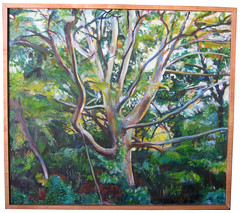Hi.
In the next few weeks I plan to write in a brainstorming fashion about particular paintings done in the last 2 years that I find to be important. Any feedback, positive or negative is welcome. Haters, however, can expect to be decimated by my swords of logic and reason.
Click the image to see a larger version.
Here we go:
Julie’s Sycamore is painting done in exchange for several months of electric utility bills. I painted it as a commissioned gift, for Julie, who happened to love this particular tree. The tree is located behind Julie’s old house in Pittsburgh, on one of many steep slopes in that region. My old house mates, Sara and Mark, bought that house from Julie and her husband directly and wanted to give this painting as a gift of gratitude.
Sycamores are massive yet smooth barked. The bark exfoliates as the tree grows and leaves a mottled, almost camouflaged look. The tree is well suited to grow in urban environments. As uncovered during 3 Rivers 2nd Nature, the tree is 1 of the 3 most prevalent trees along the 3 Rivers corridors in Allegheny County.
The tree is massive and smothered lovingly in it’s forested surroundings. The sky in the background filters through the leaves and is ultimately the source of all the marks and colors. It is interesting to note that the source of light is coming from is the right hand side and nearly all of the branches on the Sycamore are reaching toward it. To call it self-referential would somewhat cheapen that concept. I am used to the idea that form can be drawn up out of it’s relationship to light, but the record of growth indicated by the direction of the branches takes that into a temporal direction. The tree and the light are in a dialogue with each other. The light reflecting off the tree creates the form of the tree, which grows and is guided by the light.
I’m not sure if I am communicating this appropriately. But it is boggling my mind right now to recognize that this is all in paint.
The amount of detail in such a scene is too much to paint. If it were all painted I imagine it would look stale. I paint much how Hawthorne describes painting. Spots of color. You paint spots of color, from large to small and the painting has a way of forming itself. The way that unfolds feels surprisingly like the game go, as if the lights and darks in the image are in a dance of tension with one another.
I paint in approximations.
The tree is placed in the center of the composition, with a slight look upwards. The fact that the viewer seems to be slightly below the tree, coupled with its massiveness, conveys a sense of grandeur. Is the tree a god? Is the tree a ecological sentinel, standing guard over my old housemates in their new home?
Divorced from the personal meaning of this tree for me, I believe the painting still holds weight. I think that is because of the technical handling and execution. The brushwork is incredibly loose upon close inspection, yet incredibly cohesive from a distance. The surface is fractured with a logic to the surface of the painting. Within those fractures are bits of controlled chaos.
There seems to be a lack of a firm footing for the viewer, and yet the tree is [pardon me] firmly rooted. That, coupled with the care for this particular tree deserves to have its story told.
In many of my paintings of late, I have been after a surface logic that is somewhat stylized, but seems to be at the core of what constitutes a “good painting” for me. A surface integrity that interlocks perfectly.
The best and well known example of this that is SOMEWHAT similar is the interlocked sense in Van gogh’s painting “Starry Night”. This quality aides the fact that your eye is compelled to move across the whole painting, and that might be all it is… finding paths to direct the path of viewing the whole canvas. The more I chase this, the more I am able to make it work. But I am not sure I have gotten it to work across a whole painting. In this work, there is a stubborn bump in the too thick branch on the upper left corner.
The tree becomes a symbol: a stake in the ground signifying the memory of experience of place for Julie, the gratitude my housemates have for being able to move into this space, and a sentiment that grows close to the people I lived with in Pittsburgh and directly left behind as I moved to Philadelphia.
Our relationship to nature and others is ultimately shaped locally.
